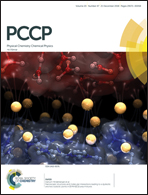Feature optimization for atomistic machine learning yields a data-driven construction of the periodic table of the elements†
Abstract
Machine-learning of atomic-scale properties amounts to extracting correlations between structure, composition and the quantity that one wants to predict. Representing the input structure in a way that best reflects such correlations makes it possible to improve the accuracy of the model for a given amount of reference data. When using a description of the structures that is transparent and well-principled, optimizing the representation might reveal insights into the chemistry of the data set. Here we show how one can generalize the SOAP kernel to introduce a distance-dependent weight that accounts for the multi-scale nature of the interactions, and a description of correlations between chemical species. We show that this improves substantially the performance of ML models of molecular and materials stability, while making it easier to work with complex, multi-component systems and to extend SOAP to coarse-grained intermolecular potentials. The element correlations that give the best performing model show striking similarities with the conventional periodic table of the elements, providing an inspiring example of how machine learning can rediscover, and generalize, intuitive concepts that constitute the foundations of chemistry.

- This article is part of the themed collection: 2018 PCCP HOT Articles


 Please wait while we load your content...
Please wait while we load your content...